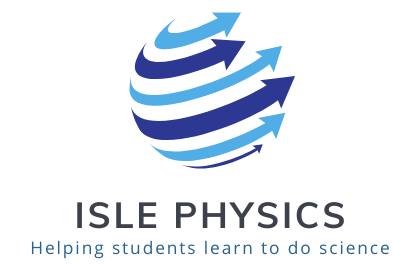Eugenia Etkina December 2nd
Hello everyone, I continue with gases today. My post is about how we do derivations in the ISLE approach. Many of my posts are about conceptual reasoning and experiments, they might cause you to wonder: what about deriving stuff? How do students do it? We have many different approaches engaging students in deriving mathematical relations. One of them is by giving them tables of data to find patterns (I showed those for Newton’s second law) and have them in lots of chapters. But sometimes, we actually let students derive complicated mathematical relations. One of those relations is the dependence of the ideal gas pressure on the number of particles in unit volume, their mass and speed.
It is important to remember that this derivation simplifies even more the model of ideal gas – in the ideal gas particles are point-like objects that only interact with each other in direct collisions and obey Newton’s laws. To derive the above relation, one also needs to assume that the particles to not collide with each other but only with the walls of the container and by default move with different velocities.
Here is how we guide the students through the derivation: We ask them a small question, tell them what they should have as an answer and let them figure out how to get to that answer. Then we ask the next question and again give them the answer and ask them to figure out how to get to it. Please take a look and see if your students would be able to follow.
Note, that we do not ask the students to read the book before they come to class, instead we ask them to struggle with the derivation and only AFTER that read the textbook. This approach is orthogonal to the flipped classroom approach that encourages the students to read the textbook first and then engage in discussions in class. Our approach to derivations is based on the innovation-efficiency corridor introduced by Schwartz and Bransford. I can talk more about it if people are not familiar with it. Please, if you read to the end, do not forget to respond – like it, post comments, anything that will make the post more visible.
- Gorazd Planinsic
- I know I posted this video some time ago, but it fits this topic so well…https://youtu.be/x2F581mFVM8
- YOUTUBE.COM
- Mechanical model of gas pressure
Eugenia Etkina November 30th.
Hi all, I am continuing with Chapter 12, Gases (check out the OALG file posted here for all of the activities). Please do not forget to respond to the post to make it more visible.
As the first two activities that I posted two days ago showed, this chapter is ripe for opportunities to practice our unique ISLE-based reasoning – inventing multiple explanations for the observed phenomenon, and learning to systematically reject them by systematic testing. The next two activities that I am posting today allow for similar steps but even better. They relate to the development of the concept of pressure that moving microscopic particles exert on the walls of the container. I am posting the first activity below and AFTER I will share my experience with the students that leads to the second activity. So, here is the first one:
OALG 12.2.1 Observe and explain
Equipment: a balloon.
Blow up a balloon and carefully observe how its shape changes during the process. Use the idea of moving particles to explain why it expands when you blow air into it. Explain why the balloon does not expand any more when you stop blowing. Describe an experiment you can perform to test your explanation(s).
The idea here is that not only the stretched rubber of the balloon stops its expansion due to the hits of the air particles inside it, but also the particles or the outside air bumping from outside. It is this exact idea that one of my students (who never had physics before) expressed in in class. Immediately after, another student (I even remember his name, although it was 20 years ago, Jabari), Jabari, says: Wait a minute. If this is true and the particles of air are preventing the balloon from further expanding, then the un-inflated sealed balloon should expand by itself if we put it in a vacuum! But this will never happen, how can a balloon inflate by itself?
Luckily, I had a vacuum jar and a balloon handy, so we did the experiment and voila! the balloon inflated! There was this audible gasp of the whole class. Jabari predicted this crazy thing! They clapped and smiled and Jabari became my best student that year. Now, Jabari’s idea is implemented in our materials. See the next activity below.
OALG 12.2.2 Test multiple explanations
In the experiment in the video [https://mediaplayer.pearsoncmg.com/…/secs-egv2e-testing…], a partially inflated (and tied) balloon will be placed in the bell-jar and the air will be removed by the vacuum pump. Use each of the ideas you came up with in Activity 12.2.1 to make predictions about what the balloon will do when the air is pumped out of the bell-jar (state one prediction for each idea being tested). Write down your predicted outcome(s). Then watch the experiment. Which of your predictions was consistent with the experimental outcome? What is your judgment on each of the ideas you were testing?
If you read to the end, please do not forget to like the post to make it more visible.

